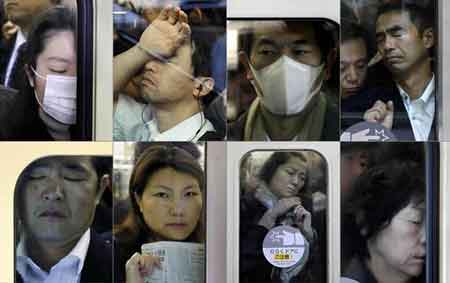 |
|
Packed like sardines into sweaty, claustrophobic carriages, these passengers can barely breathe let alone move about freely. |
|
If you think your commute is a living hell, then spare a thought for these subway passengers in Tokyo. Packed like sardines into sweaty, claustrophobic carriages, these passengers can barely breathe let alone move about freely. The photographs are the work of Michael Wolf, a German-born artist who has been capturing the cramped conditions of the Japanese capital's transport network for 15 years. Tokyo is world famous for its urban density and so the public transport nightmare is hardly surprising. Standing on the platform as the doors snap shut, Wolf has been able to capture a whole range of expressions from his unwilling and trapped subjects. Some stare disconcertingly at the lens, others close their eyes to try and escape the brutal overcrowding, while others have their faces contorted against the steamy glass windows. Wolf first experienced the Japanese subway network when reporting on the aftermath of the sarin nerve gas attack which killed 16 people and injured 6,000 in 1995. His collection of images quickly grew into a portfolio first exhibited in 2008. 'I shot six frames of faces of early morning commuters in subway windows which turned out to be very powerful images,' said Wolf. 'I spent 20 days [Monday to Friday] every morning from 7.30 until 8.45 at the same subway station shooting portraits of people on their way to work.' 'The images create a sense of discomfort as his victims attempt to squirm out of view or simply close their eyes, wishing the photographer to go away,' reads the description on Wolf's website. Eleven million commuters use Tokyo's transport network every morning, with suburban and subway trains reliably packed to the brim from first light to late morning. It is a sign that Tokyo's tsukin jigoku [commuting hell] has grown steadily out of hand that the railway companies have employed white-gloved oshiya (pushers) to shove passengers into carriages since 1955. Regular commuters have become deft at performing what is known as the Tokyo pirouette, which allows them to slide into the carriage and then stand without having to make eye contact with those who have moved aside. Scuffles between frustrated commuters have become more and more common, while notorious chikan [subway molesters] take advantage of the overcrowding to fondle fellow passengers. Passengers are well trained in using whatever they have on them - bags, briefcases and umbrellas, for example - to fight for space. Police have reported a massive rise in 'commuter incidents' - injuries and assaults. (Read by Brian Salter. Brian Salter is a journalist at the China Daily Website.) (Agencies) |
如果你覺(jué)得自己的上班路上太擁擠,不妨想想東京地鐵上的乘客。車廂內(nèi)擠得像沙丁魚罐頭一樣,汗臭和幽閉的車廂讓人幾乎無(wú)法呼吸,更不用說(shuō)自如走動(dòng)了。 這組照片是德國(guó)藝術(shù)家邁克爾?沃爾夫拍攝的。他花費(fèi)了15年時(shí)間,用鏡頭記錄了東京交通的擁擠狀況。 東京是全球聞名的人口高密度城市,因此公共交通擁擠如噩夢(mèng)一點(diǎn)都不意外。 車廂門一關(guān)上,沃爾夫便開(kāi)始在站臺(tái)上捕捉人們的豐富表情。乘客通常不愿被拍攝,但也無(wú)處挪身。 一些乘客窘迫地盯著鏡頭,另一些人閉上眼睛試圖逃開(kāi)無(wú)情的擁擠場(chǎng)面,還有一些人的臉扭曲地貼在沾滿水珠的車廂玻璃窗上。 1995年?yáng)|京地鐵遭遇沙林毒氣襲擊后,沃爾夫來(lái)到東京采訪,首次體會(huì)到東京地鐵的擁擠。那次毒氣襲擊事件造成16人死亡,六千人受傷。2008年他用這些照片舉行了第一次攝影展。 沃爾夫說(shuō):“我隔著車窗拍了六組早晨上班族乘地鐵的照片,這些照片影響很大。” “我花了20天時(shí)間,每周一到周五的早上7時(shí)30分到8時(shí)45分,在同一個(gè)地鐵站拍攝那些坐地鐵去上班的人。“ “這些照片產(chǎn)生了一些不適感,因?yàn)楸慌恼咴噲D逃避鏡頭或者只是閉上眼睛,希望拍攝者走開(kāi)。”沃爾夫在自己網(wǎng)站上這樣寫道。 每天早晨,東京有1100萬(wàn)人乘坐地鐵,從黎明到上午,城鐵和地鐵都擠得沒(méi)有一絲縫隙。 東京“通勤地獄”逐漸失控的一個(gè)標(biāo)志就是,早在1955年,東京地鐵公司就雇傭了帶著白手套的“推手”們,把乘客塞進(jìn)車廂。 東京上班族紛紛變成擠地鐵的高手,可以迅速擠進(jìn)車廂,還可以僅靠腳尖站立,不與那些被擠到一邊的人有任何眼神交流。 地鐵乘客之間的爭(zhēng)斗也越來(lái)越司空見(jiàn)慣,臭名昭著的地鐵猥褻者則趁機(jī)非禮他人。 “訓(xùn)練有素”的乘客們可以使用手上的各種物品,如背包、公文包、雨傘等來(lái)爭(zhēng)奪空間。日本警方稱,發(fā)生在地鐵上班族身上的受傷和襲擊事件大幅增長(zhǎng)。 相關(guān)閱讀 調(diào)查報(bào)告稱福島核事故為“人為災(zāi)難” (中國(guó)日?qǐng)?bào)網(wǎng)英語(yǔ)點(diǎn)津 Julie 編輯:陳丹妮) |
|
Vocabulary: spare a thought for: 想到,替某人著想 claustrophobic: 導(dǎo)致幽閉恐怖癥的,令人不適地被關(guān)閉或被包圍的 squirm out of: 逃避 pirouette: (芭蕾舞中的)單腳尖旋轉(zhuǎn) molester: 猥褻者,性騷擾者 |
